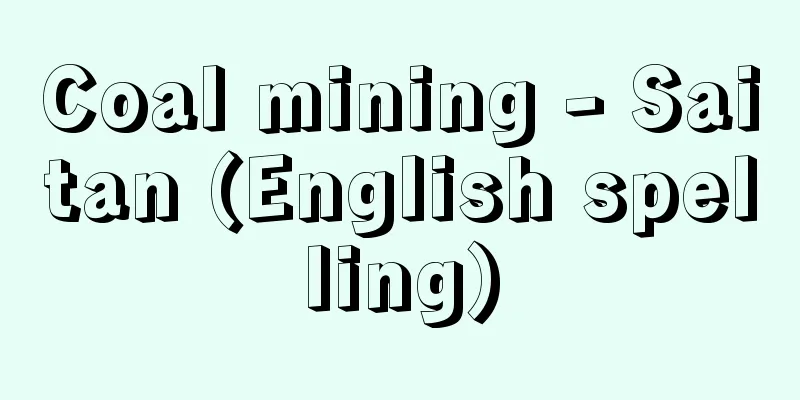Coal mining - Saitan (English spelling)

|
Coal mining is the process of digging up the coal seam and loading the coal onto a coal transporter installed at that site. Coal mining can be broadly classified into open-cut mining and underground mining. [Toshiro Isobe] Open-cut miningCoal is extracted by removing the topsoil and bedrock covering the coal seam to expose it. This requires stripping soil, felling trees, loosening the ground, restoring the excavated area, planting trees, and building sabo dams to prevent damage to farmland and villages at the foot of the mountain caused by soil and bedrock washed away by rain. Considering these various costs, there is a limit to the amount of stripped soil that can be used in relation to the amount of coal extracted, and the general guideline is about 10 times the amount of coal. In recent years, with the arrival of large excavators and trucks, the depth at which open-cut mining can be carried out has gradually increased, but this is not desirable in terms of environmental destruction and loss of greenery. On the other hand, it has the advantage that mining costs are low and there are no safety issues such as gas. A famous example of open-cut mining is the Fushun coal mine in Liaoning Province in northeastern China, where annual coal production reaches 2 to 3 million tons. However, open-cut mining is not limited to Fushun; it is also actively carried out throughout China, the United States, Canada, Australia, and European countries. In Japan, it is carried out on a small scale in various parts of Hokkaido and Yamaguchi Prefecture, and has become a source of cheap coal for power generation. Open-cut mining is attractive to coal dealers because it is cheap and safe, but it is destined to disappear eventually because it is not possible to dig deep enough. [Toshiro Isobe] Underground miningSince the majority of coal mining is done underground, we will first explain the most typical form of underground mining. Underground mining requires the construction of tunnels underground. Coal beds are sedimentary rocks, so they should have originally been horizontal, but subsequent geological changes have caused them to tilt, break, or bend. shows a cross-section of a stratum. "Shoulder" and "deep" in the diagram are mine slang for up and down. The terms "strike" and "inclination" are used to describe the state of the stratum. Strike refers to the intersection of the stratum with a horizontal plane, and the strike of a coal bed is also the intersection of the coal bed with a horizontal plane. When mining a coal seam, two parallel tunnels (tunnels excavated into the coal seam are called side tunnels) are dug about 100 to 200 meters apart at the shoulder and depth of the seam. The one along the shoulder is called the upper tunnel (shoulder side tunnel, large shoulder tunnel), and the one at the depth is called the gate tunnel (deep side tunnel). When these two tunnels are connected by a side tunnel in the inclined direction, this tunnel is called a coal preparation ascent (also simply called a mining preparation ascent), and one of the side walls of this tunnel becomes the mining face (kiriha). When only one side becomes the mining face, it is called single-wing mining, and when both sides become mining faces, it is called double-wing mining. The mined coal is transported from the shoulder to the depth, loaded onto a coal conveyor at the gate tunnel, and transported away. The ventilation air travels through the gate tunnel in the opposite direction to the coal transport, washing along the shoulder from deep along the face, before being discharged through the upper tunnel. There are two methods of operating a coal face: one in which a gate and a top plate for transporting coal and ventilation are dug in advance, and the other in which a gate and top plate are installed at the site of the mine. The former is called the retreating mining method, and the latter is called the forward mining method. Both have advantages and disadvantages in terms of the stability of the coal seam, but the retreating method is considered to be better in terms of both safety and mining. The mined coal transported to the gate tunnel flows into the "vertical entry tunnel" on the deeper side, and then passes through the "deep flat-panel tunnel" excavated in the direction of the coal seam's strike, before being transported outside the mine via an inclined shaft or vertical shaft. Ventilation is in the exact opposite direction to the coal transport direction, and the shoulder vertical entry and shoulder flat-panel tunnels serve as exhaust vents. Shoulder and deep flat-panel tunnels can be located on either the upper or lower wall of the coal seam, but are more commonly located on the lower wall. [Toshiro Isobe] Charcoal cutting methodThe process of digging out a coal seam is called "tangiri". In the past, pickaxes were used, but later blasting and coal picks became the main methods. After 1948, mechanized coal mining was introduced to improve the efficiency of coal mining (the amount of coal produced per worker per month), and coal cutters, coal ploughs (Korenhobel), and drum-type coal cutters came into widespread use, completely changing the mining style. This is because the iron poles and capes that began to be used in West Germany after World War II replaced the traditional face support method using wooden poles and wooden beams, and eventually led to self-propelled supports and shield frames. However, coal picks and blasting are still used to mine steeply sloping coal seams, and even in the case of mechanized mining, blasting is often used in combination to loosen the coal seam and make it easier to cut. One unique method of cutting coal in steeply sloping seams is hydraulic mining using high-pressure water jets. The former Sunagawa coal mine in Hokkaido is an example of successful hydraulic coal mining in Japan. Japanese mining methods that Japan can be proud of include hydraulic coal mining at Sunagawa and ultra-heavy-duty mechanized coal mining (combining a shield frame and a drum cutter, also known as the SD method) at the former Pacific Kushiro coal mine, and these techniques are also exported overseas. [Toshiro Isobe] othersCoal mining is the lifeblood of a coal mine. Therefore, both efficiency and safety must be high. All of the mining methods mentioned so far are called the long wall system, but there are also other methods such as the pillar system, in which coal is extracted by digging tunnels in a checkerboard pattern in the coal seam and then abandoned, and the pit system, in which coal is excavated from the bottom up in steeply sloping seams, temporarily storing the excavated coal in the excavated pit, and then removed from below. However, these methods are not recommended. In addition, in order to make mining more efficient, intensive mining, in which mining faces are gathered in one area, and compartmentalized mining, in which independent sections are created to prevent disasters from spreading to other work sites, should be applied depending on natural conditions. The current problem with the Coal Mining Act is the establishment of a method for mining steeply inclined seams (40 degrees or more). In other words, from a safety standpoint, there is a condition that the mined area must be completely filled with waste rock, and no good method has been found. Steeply inclined coal seams are concentrated in the Ishikari coalfield in Hokkaido, and this has been a major problem. [Toshiro Isobe] [References] | | | |©Shogakukan "> Coal seam status (figure) Source: Shogakukan Encyclopedia Nipponica About Encyclopedia Nipponica Information | Legend |
|
炭層を掘り崩し、その場所に設置してある運炭機へ石炭を積み込むまでの作業を採炭という。採炭を大きく分類すれば、露天掘りと坑内掘(こうないぼ)りになる。 [磯部俊郎] 露天掘り炭層の上を覆っている表土および岩盤を取り除いて炭層を露出させて採掘するため、剥土(はくど)、樹木の伐採、地盤の緩みなどのため、掘り跡の復原、植樹、および土砂、岩盤などが降水で流出して、山麓(さんろく)の農地、集落などに被害を生じないよう砂防(さぼう)ダムの建設が必要である。これらの諸費用を考えると、採掘炭量に対する剥土量には限界があり、一般には炭量の10倍ぐらいが目安になっている。近年大型のショベルカーおよびトラックができるようになってから、露天採掘のできる深さもしだいに増大の傾向にあるが、自然破壊、緑の消失などの点からは、あまり好ましいとはいえない。しかし一方では、採掘費が安く、ガスなどの保安問題がない点で有利である。露天掘りで有名なのは、中国東北部遼寧(りょうねい)省にある撫順(ぶじゅん)炭鉱で、ここでは露天掘りによる産炭量が年200万~300万トンにも達する。しかし、露天掘りは撫順に限らず、中国各地、アメリカ、カナダ、オーストラリア、ヨーロッパ各国でも盛んに行われている。日本でも、北海道の各所や山口県で小規模ながら実施されていて、発電用として安価な石炭の供給源になっている。露天掘りは安価、安全の点から石炭業者には魅力はあるが、深い所までは掘れないので、いずれはなくなってしまう運命にある。 [磯部俊郎] 坑内掘り採炭の主体は坑内掘りであるから、まずもっとも典型的な坑内掘りの形について説明する。坑内掘りは、地下に坑道を展開しなければならない。 炭層は堆積(たいせき)岩であるから、元来水平なはずであるが、その後地質的変動により、傾斜したり、ちぎれたり、折れ曲がったりしている。は地層の断面図である。図中の「肩(かた)」「深(ふけ)」は坑内用語で上、下の意味である。地層の状態を表現するのに走向(そうこう)と傾斜という用語がある。走向とは地層と水平面との交線のことで、炭層の走向も炭層と水平面との交線である。 炭層の採掘にあたって、層内の肩、深に約100ないし200メートル離して走向方向の平行坑道(炭層内に掘削した坑道を沿層(えんそう)坑道という)を2本掘る。肩部沿層を上添(うわぞい)坑道(肩沿層坑道、大肩坑道)、深のそれをゲート坑道(深沿層坑道)という。これら両坑道を傾斜方向の沿層坑道で結ぶとき、この坑道を採炭準備昇(のぼり)といい(単に採準昇(さいじゅんのぼり)ともいう)、この坑道のどちらかの側壁が採掘面(切羽(きりは))となる。一方のみが採掘面となる場合を片翼採炭、両側壁とも採掘面になる切羽の進め方を両翼採炭という。採掘炭は肩から深へと運搬され、ゲート坑道の運炭機に積み込まれて運び出される。通気はゲート坑道を運炭と逆方向に進み、切羽面を深から肩に沿って洗いながら上添坑道を経て排出される。 採炭切羽の運用法にはあらかじめ運炭・通気用の上添、ゲートを掘っておく方法と、上添、ゲートを採掘跡にもつものがある。前者を後退式採炭法、後者を前進式採炭法という。両者とも炭層の存在状態の安定性の点からみて利点、欠点はあるが、どちらかといえば、後退式が保安上も採掘上にもよいとされている。 ゲート坑道に運ばれた採掘炭は深側の「立入(たていれ)坑道」に流入し、さらに炭層の走向方向に掘削された「深片盤(かたばん)坑道」を通って、斜坑または立坑を経て坑外に搬出される。通気は運炭方向とまったく逆であり、肩立入、肩片盤坑道が排気風道になる。肩、深の片盤坑道は炭層の上盤(うわばん)にあっても下盤(したばん)にあってもよいが、一般には下盤が多い。 [磯部俊郎] 炭切り法炭層の掘り崩しを炭切(たんぎ)りという。昔はつるはしであったが、その後発破とコール・ピック主体に変わってきた。1948年(昭和23)以降、採炭能率(労働者1人1か月当りの産炭量)向上のため、機械化採炭が取り入れられ、コール・カッター、コール・プラオ(コーレン・ホーベル)、ドラム式コール・カッターなどが大幅に用いられるようになり、採掘様式は一変した。これは、第二次世界大戦後、西ドイツなどで用いられ始めた、鉄柱、カッペが従来の木柱、木梁(もくりょう)による切羽支保法にとってかわり、その行き着く先が、自走支保、シールド枠になったことによる。しかし、急傾斜の炭層の採掘にはまだコール・ピックおよび発破が用いられているし、機械採炭の場合でも炭層を緩めて切削を容易にするため発破が併用されている場合が多い。急傾斜層の炭切り法として独特なものに、高圧水の噴射による水力採炭がある。北海道の旧砂川炭鉱は日本での水力採炭に成功した例である。日本の採掘法で世界に誇れるものは砂川での水力採炭、旧太平洋釧路(くしろ)炭鉱での超重装備機械化採炭(シールド枠とドラム・カッターを組み合わせたものでSD採炭法ともいう)であり、海外へも技術輸出を行っている。 [磯部俊郎] その他採炭は炭鉱の生命である。したがって能率、保安とも高度のものでなければならない。これまで述べてきた採炭法はいずれも長壁(ちょうへき)式(ロング・ウォール・システム)と称するものであるが、このほか残柱(ざんちゅう)式(柱房式)といって炭層中に、碁盤目のように坑道を掘ることで採炭し、あとは放棄するもの、また、急傾斜層では、下から上に向かって掘り上がり、採掘炭を掘跡に一時ため込んでから、下から抜き取る溜(ため)掘り式などがあるが、推奨できる方法ではない。 また、採掘を高能率化するため、一区域に切羽を集める集約採炭、災害などを他の作業場に波及させないため独立区画をつくる区画採炭も自然条件に応じて適用すべきである。 現状で採炭法上の問題点は、急傾斜層(40度以上)採掘法の確立である。つまり、保安的見地から採掘跡を廃石などで完全に充填(じゅうてん)しなければならないという条件がつきまとうため、よい方法がみつかっていない。北海道の石狩炭田には急傾斜炭層が集中しており、大きな問題となっていた。 [磯部俊郎] [参照項目] | | | |©Shogakukan"> 炭層の状況〔図〕 出典 小学館 日本大百科全書(ニッポニカ)日本大百科全書(ニッポニカ)について 情報 | 凡例 |
<<: Altar - Saidan (English spelling) altar English
>>: Saitama Prefecture - Saitama
Recommend
Mendoça, JG (English spelling) MendocaJG
…The missionaries, in order to carry out their du...
phase variation
…The latter outbreaks are often seen in insects t...
Zamoyski, A.
…In 1765, he established a knight's school to...
Aonohara
[1] A plain in the west of Ogaki City, Gifu Prefec...
Kai-zhong-fa (English spelling)
A type of trade law enacted during the Ming Dynast...
Botta, PE (English spelling)
...The reason why such a wide and diverse academi...
Giant nucleus - Giant nucleus
Please see the "Macronuclear" page. Sou...
Nilakaṇṭha (English spelling)
…Once, when a deadly poison appeared from the sea...
Toy Pumpkin - Toy Pumpkin
…(2) Western pumpkin C. maxima Duch. (English nam...
Hui faction - Kiha
… The Ming Dynasty's Wen Peng (1498-1573) was...
Gassho (architecture)
…There are various types with different beam spac...
Agricultural Orlgins and Dispersals (English)
… Useful crop plants [Yasushi Sakamoto]. … *Some ...
Vespertilio
…The superfamily Phyllostomatoidea includes the t...
Bristol Channel
A large inlet that extends from the Atlantic Ocea...
Dicaeidae
…Any of the birds of the passerine order, family ...
![Albergo (English spelling) [Italy]](/upload/images/67cadf5572457.webp)








